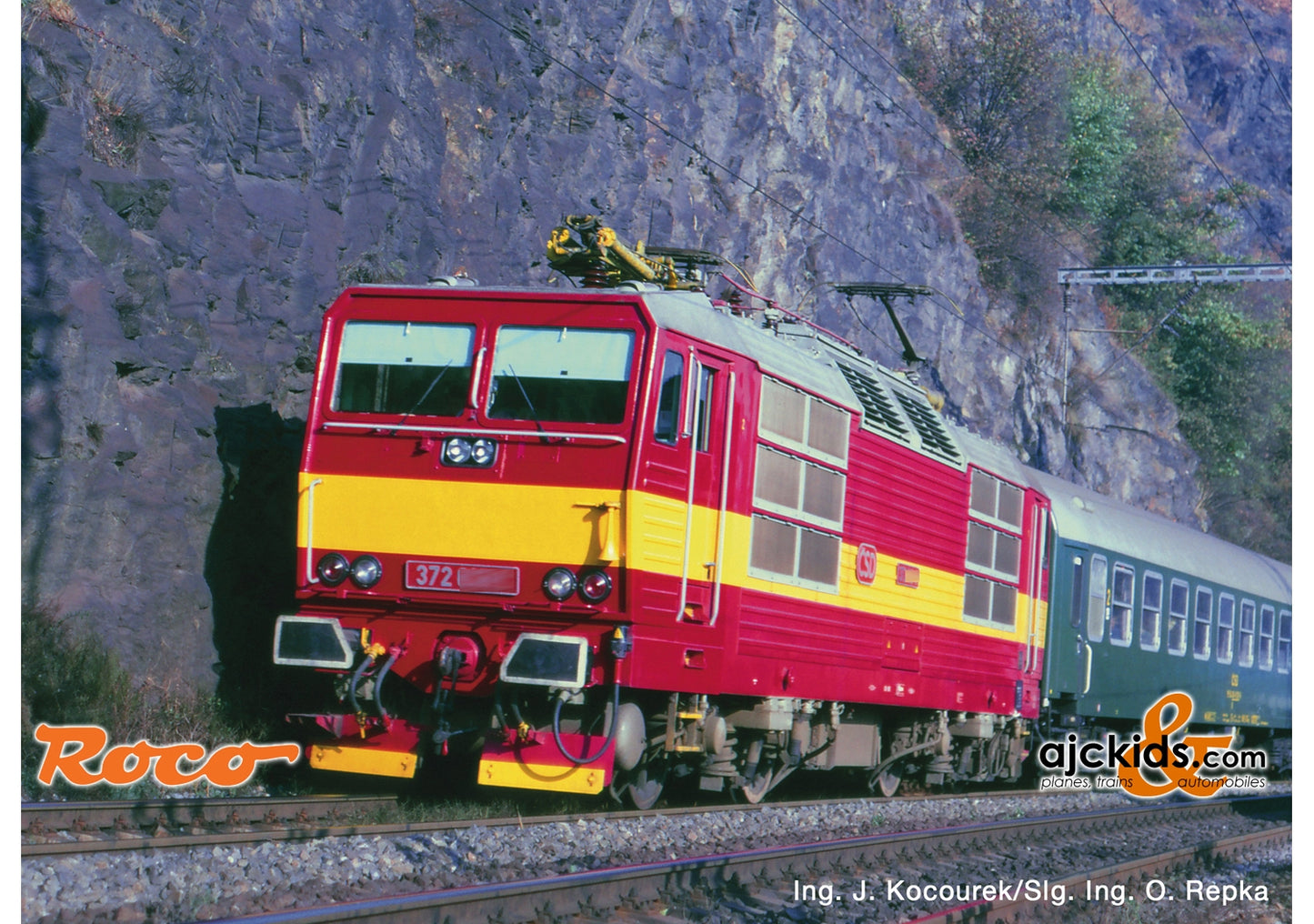Roco 71221 - Electric locomotive class 372
Completely new design!
■ Finely detailed model with many separately applied plug-in parts
■ Completely newly-developed current collectors with innovative attachment
■ Elaborate roof area design as well as the ventilator slats allowing an unobstructed view
■ Delicate design of the bogies as well as the spoked wheels
■ With rail guards and air tanks in closed form for realistic presentation in display cabinets
■ Rear signal can be switched using a DIP switch
In the 1980s, the DR purchased electric dual-mode locomotives to improve operating procedures in the steadily growing cross-border traffic on the railway lines between Berlin–Dresden–Prag.
However, the locomotive builder in the GDR, LEW Hennigsdorf, was working at full capacity at the time. Hence, the Czech locomotive factory Skoda, which already had gathered various experiences with such machines, received the order. The CSD series ES 499.1 and 499.2 served as a basis for the construction and design. However, new ground was broken with the German 15 kV/16⅔ Hz power system. The double order contained 15 locomotives series 372 for the CSD and 20 locomotives series 230 for the DR.
The universal locomotives were used to haul passenger and goods trains. With an hourly power output of 3.260 kW, the locos reached a maximum speed of 120 km/h. In Germany, the series is affectionately called "Dumpling Press" whereas its Czech counterpart is called "Bastard".
| Specifications: | |||||||||||||||||||||||||||||||||||||||||
|
|
||||||||||||||||||||||||||||||||||||||||
Suitable for the D374/375 “Vindobona/Hungaria”, items 74188, 74189, 74190
Prototype Information
In the 1980s, the Czechoslovakian State Railway (CSD) and the Deutsche Reichsbahn (DR) decided to procure dual-system locomotives in order to simplify the consistently-increasing flow of traffic and operational processes in cross-border transport along the Berlin-Dresden-Prague line. The development, construction and testing of these locomotives took place as a collaborative, joint project between the two railway companies. The locomotive builder in the GDR, the LEW Hennigsdorf, was operating at full capacity at this time, meaning that the Czech Škoda locomotive factory, which had already had diverse experiences with multiple-system locomotives, received the contract. However, the German 15 kV/ 16 2/3 Hz electricity system was uncharted territory for them. The CSD classes ES 499.1 and 499.2 served as a basis. The construction of the AC units, with which Škoda was unfamiliar, was taken on by LEW in Hennigsdorf.
In 1998, one prototype was delivered to each railway. The CSD prototype, the 372 001, was painted in blue with a yellow banderole and a grey roof. In the 1990s, the locomotive was adapted in colour to the series deliveries, and from then on was therefore painted in wine red with a yellow banderole. The prototypes were tested by both railway administrations over a four-year test phase under various operating conditions. Subsequently, the knowledge gained was taken into consideration by the manufacturers, and from 1991, a further 14 BR 372 locomotives were supplied to the CSD, and 19 BR 230 locomotives were supplied to the DR.
The general-purpose engines were deployed in express and freight train transport. With an hourly output of 3,260 kW, a maximum speed of 120 km/h could be achieved. All the locomotives in the CSD 372 class were stationed in Ústí nad Labem (Aussig). In Germany, the locomotives of this class were lovingly nicknamed “Knödelpresse” (dumpling press). The Czech counterpart went by the name of “Bastard” in the neighbouring country. The development of the Decín–Prague connection at a maximum speed of 160 km/h made it necessary to upgrade several locomotives. From 1994, six Czech BR 372 locomotives were adapted for international express tourist travel and have since then run under the class designation 371 – “Turbobastard”.
The CD relocated these converted engines to the Prague depot. When the CD Cargo freight division was founded in the year 2007, nine locomotives were assigned to the new company. Thanks to the fact that, until 2016, they were the only locomotives used by CD Cargo which could be used in German railway networks, all the engines were gradually modernised and repainted in the new company colours. In addition to the main area of deployment for the transportation of trains at the border crossing point Decín/Bad Schandau (continuing to Dresden and Leipzig), the locomotives were occasionally used in inland transport, and also ran right up to the border stations to Poland.
EAN/UPC: 9005033712211



